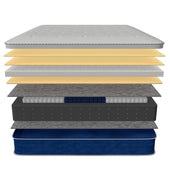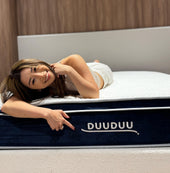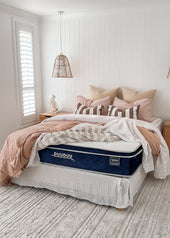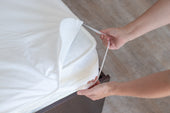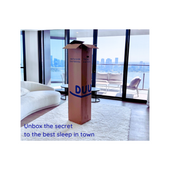Sleep is one of the few necessities that binds people of all ages.
Whether you're just entering adulthood, navigating the daily grind of your career, or enjoying your retirement years, quality sleep is essential.
And at the heart of quality sleep is a good mattress.
Choosing the right mattress isn’t a one-size-fits-all decision.
Different life stages come with different needs, preferences, and even health issues.
In this guide, we break down how to choose the right mattress for young adults, working professionals, and older individuals—ensuring restful sleep for every phase of life.
Why the Right Mattress Matters
Before we look into age-specific recommendations, it’s important to understand why choosing the right mattress is so critical:
1. Sleep quality affects overall health: From immunity to focus, poor sleep impacts nearly every bodily system.
2. Bad mattresses can cause chronic pain: Sagging or unsupportive beds contribute to back, hip, and neck pain.
3. Lifespan of a mattress: A good-quality mattress lasts 7–10 years. Investing in the right one saves money in the long term.
4. One person’s “comfortable” is another’s nightmare: Body type, sleep position, and age-related concerns all play a role in mattress comfort.
1. Mattresses for Children
Children grow rapidly—physically and cognitively—and their sleep environment plays a major role in development.
A child’s spine and bones are still forming, which means they need consistent support without being too firm or too soft.
What Children Need in a Mattress:
a. Spinal alignment for growing bones and muscles
b. Hypoallergenic materials to reduce allergen exposure
c. Durable and waterproof protection for accidents or spills, like DuuDuu's waterproof mattress protector
d. Good edge support to prevent falls in smaller beds
Recommended Mattress Types:
a. Innerspring Mattresses: Offer firm support and bounce; good for active sleepers.
b. Memory Foam (CertiPUR-US certified): Conforms gently to growing bodies while minimizing pressure points.
c. Hybrid Mattresses: Best for older children who may prefer a more “adult” feel with added comfort.
Safety and Hygiene Considerations:
a. Ensure the mattress is low in VOCs (volatile organic compounds).
b. Look for a mattress cover that’s removable and washable.
c. Waterproof protectors are a must, especially for children under 8.
Firmness Level:
a. Medium-Firm (6–7/10): Provides essential spinal support.
b. Avoid plush or very soft beds that can cause spinal misalignment.
Transitioning From Toddler to Bigger Beds:
a. Ages 2–4: Crib-to-toddler mattresses should be firm and breathable.
b. Ages 5–7: Twin or full-size mattresses with supportive foam or coils.
c. Ages 8–12: More options open up; hybrids or latex with a medium feel work well.
2. Mattresses for Working Adults (Ages 30–55)
This stage is often the busiest—with careers, families, and stress at their peak.
Long hours of sitting or physically demanding jobs can lead to aches and tension that make mattress quality even more important.
What Working Adults Need:
a. Spinal alignment for back health
b. Reduced motion transfer (for couples)
c. Cooling features (especially for stress-related heat sensitivity)
d. Durability under daily wear
Best Mattress Types:
a. Hybrid Mattresses: Excellent for back support and airflow.
b. High-Density Memory Foam: Good for side sleepers and people with joint pain.
c. Latex mattress: Latex gently supports the natural curves of the body without letting you sink too deeply, reducing back strain while you sleep.
Pain and Stress Relief:
a. Many working adults experience lower back pain or neck stiffness. Mattresses with zoned support (firmer in the center, softer at the edges) can help maintain healthy posture.
b. Look for mattresses with pressure-relieving layers to alleviate hip and shoulder tension.
Recommended Firmness:
- Medium-Firm to Firm (6–8/10): Especially if you sleep on your back or stomach, a firmer mattress helps keep the spine aligned.
Couples’ Considerations:
a. Choose motion-isolating foam or hybrids to reduce partner disturbance.
b. If one partner sleeps hot and the other cold, pick a mattress with dual temperature zones or breathable layers.
3. Mattresses for Older Adults (Ages 55+)
As we age, our sleep patterns change—and so do our comfort needs.
Older adults often face challenges like arthritis, osteoporosis, reduced mobility, or chronic back pain.
The right mattress can significantly improve quality of life.
What Older Adults Need:
a. Pressure relief for joints
b. Ease of movement (not too soft or sinking)
c. Support for chronic pain or arthritis
d. Good edge support to help with getting in and out of bed
Best Mattress Types:
a. Hybrid Mattresses with Zoned Support: Help reduce pressure points while supporting the spine.
b. Latex Mattresses: Naturally buoyant and easy to move on. They offer great support and pressure relief.
c. Adjustable Beds with Mattress Combos (which DuuDuu doesn't recommend with its mattress): Ideal for seniors with circulation or back problems, especially for reading or elevating legs.
Health-Specific Features:
a. For arthritis or joint stiffness, mattresses with cooling fabric or cushioned pillow tops offer relief.
b. For those with acid reflux or snoring, adjustable bases allow for elevation and better breathing.
Recommended Firmness:
a. Medium (7-8): Gentle enough to cushion joints, yet firm enough to support the spine.
b. Avoid overly soft mattresses that can trap the body and make mobility harder.
Other Considerations:
a. Edge Support: Ensures safety when sitting or getting up.
b. Antimicrobial Covers: Helpful for sensitive skin or respiratory concerns.
c. Trial and Return Policies: Older adults may take longer to adjust, so trial periods are critical.
Cross-Stage Factors to Consider
Regardless of age, a few key elements apply to everyone:
1. Sleeping Position
a. Side Sleepers need softer surfaces for shoulders and hips.
b. Back Sleepers do well with medium-firm options for spinal support.
c. Stomach Sleepers require firmer beds to avoid lower back arching.
2. Body Weight
a. Heavier sleepers (over 100kg) benefit from firmer, more supportive mattresses.
b. Lightweight sleepers (under 60kg) may prefer softer mattresses for better contouring.
3. Temperature Regulation
a. Choose cooling mattresses if you tend to sleep hot. Materials like gel-infused foam, open-cell latex, and breathable coils work best.
4. Trial Period and Warranty
a. Look for brands offering at least 100 nights of trial and 10 years warranty to make sure you’re protected.
Signs It’s Time for a New Mattress
If you’re unsure whether your mattress still serves you well, here are clear signs it’s time for a replacement:
a. You wake up with aches or stiffness.
b. There’s visible sagging or lumps.
c. You sleep better on other mattresses (like in hotels).
d. You toss and turn more than usual.
e. The mattress is over 8 years old.
Tips for Choosing the Right Mattress
a. Test the mattress: As most mattress brands now offer 100 night trials, it is good to try the mattress at the comfort of your own home. Give your body about 21 nights before it actually gets used to the mattress.
b. Read real reviews: Pay attention to feedback from people in your age or lifestyle group.
c. Set a budget: Good mattresses range from $1000–$2500. Spend what you can afford without skimping on core features.
Conclusion
The perfect mattress can transform your sleep, improve your health, and support your lifestyle—whether you're an energetic 25-year-old, a busy 40-year-old professional, or a 70-year-old retiree enjoying peaceful nights.
What matters most is choosing a mattress tailored to your age, sleep habits, and health needs.
With the right support and comfort, every stage of life can be restful and rejuvenating.
Sleep isn’t a luxury. It’s the foundation of everything you do.
Choose wisely, and your mattress will return the favor every night.



